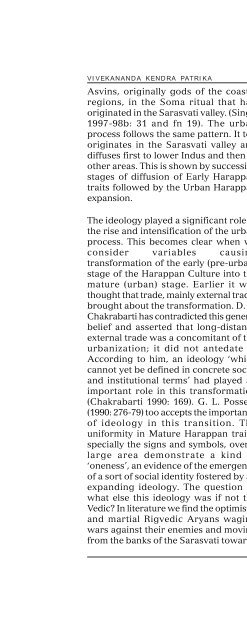Aryan Invasion Theory - Publication - Vivekananda Kendra
Aryan Invasion Theory - Publication - Vivekananda Kendra
Aryan Invasion Theory - Publication - Vivekananda Kendra
You also want an ePaper? Increase the reach of your titles
YUMPU automatically turns print PDFs into web optimized ePapers that Google loves.
VIVEKANANDA KENDRA PATRIKA<br />
Asvins, originally gods of the coastal<br />
regions, in the Soma ritual that had<br />
originated in the Sarasvati valley. (Singh<br />
1997-98b: 31 and fn 19). The urban<br />
process follows the same pattern. It too<br />
originates in the Sarasvati valley and<br />
diffuses first to lower Indus and then to<br />
other areas. This is shown by successive<br />
stages of diffusion of Early Harappan<br />
traits followed by the Urban Harappan<br />
expansion.<br />
The ideology played a significant role in<br />
the rise and intensification of the urban<br />
process. This becomes clear when we<br />
consider variables causing<br />
transformation of the early (pre-urban)<br />
stage of the Harappan Culture into the<br />
mature (urban) stage. Earlier it was<br />
thought that trade, mainly external trade,<br />
brought about the transformation. D. K.<br />
Chakrabarti has contradicted this general<br />
belief and asserted that long-distance<br />
external trade was a concomitant of the<br />
urbanization; it did not antedate it.<br />
According to him, an ideology ‘which<br />
cannot yet be defined in concrete social<br />
and institutional terms’ had played an<br />
important role in this transformation<br />
(Chakrabarti 1990: 169). G. L. Possehl<br />
(1990: 276-79) too accepts the importance<br />
of ideology in this transition. The<br />
uniformity in Mature Harappan traits,<br />
specially the signs and symbols, over a<br />
large area demonstrate a kind of<br />
‘oneness’, an evidence of the emergence<br />
of a sort of social identity fostered by an<br />
expanding ideology. The question is:<br />
what else this ideology was if not the<br />
Vedic? In literature we find the optimistic<br />
and martial Rigvedic <strong>Aryan</strong>s waging<br />
wars against their enemies and moving<br />
from the banks of the Sarasvati towards<br />
26<br />
ARYAN INVASION THEORY<br />
Indus and beyond. In archaeology we see<br />
the Mature Harappans overrunning<br />
different peoples and burning down<br />
settlements at Kot Diji in the Indus valley<br />
and at Nausharo, Gumla and Rana<br />
Ghundai west of the Indus (Lal: 1997: 91).<br />
Is this correspondence in literary and<br />
archaeological pictures not significant?<br />
In my view, the Rigvedic and Early-to-<br />
Mature Harappan identity cannot be<br />
challenged on the basis of the notional<br />
distinction between ideological and<br />
urban processes. Their identity is proved<br />
not only by geographical, chronological<br />
and cultural parities between the two but<br />
also by the interdependence and similar<br />
developmental pattern of the urban and<br />
ideological processes that they<br />
represent.<br />
III<br />
Aryattva: the ideal of Vedic Culture<br />
and its continuity<br />
The essence of Vedic Culture lies in its<br />
perception of Aryattva, a virtue, the<br />
achievement of which is considered to<br />
be necessary for a civilized living. The<br />
slogan ‘Krinvanto visvam aryam’<br />
(Rigveda 9.63.5) is an appeal to the divine<br />
almighty power to help achieve this ideal.<br />
Unfortunately, however, many historians<br />
have misunderstood this Aryattva.<br />
Vedic <strong>Aryan</strong>s, a reality; Indo-<strong>Aryan</strong>s, a<br />
myth Scholars have often confused the<br />
Vedic <strong>Aryan</strong>s with the Indo-<strong>Aryan</strong>s<br />
forgetting the fact that the two are<br />
different concepts. ‘Arya’ being the selfdesignation<br />
of the Vedic people, ‘Vedic<br />
<strong>Aryan</strong>s’ represents a historical reality. As

















